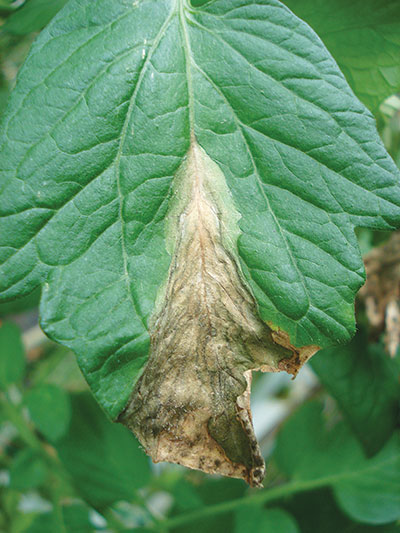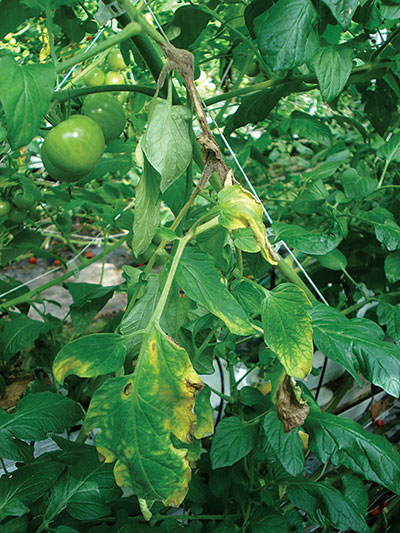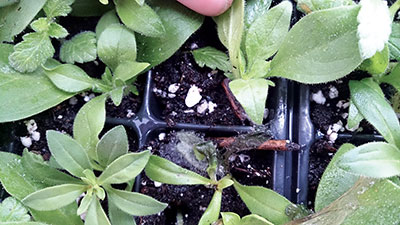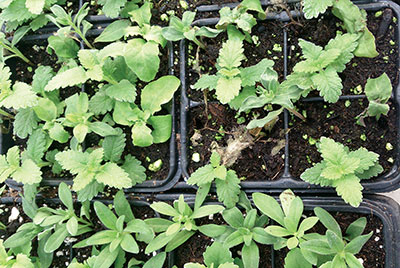
Features
Crop Protection
Inputs
Managing Botrytis
March 10, 2014 By Colin Ashbee and Matthew S. Krause
It is safe to say that nearly all greenhouse growers began to encounter
Botrytis grey moulds or blights at the start of their careers.
It is safe to say that nearly all greenhouse growers began to encounter Botrytis grey moulds or blights at the start of their careers. For many growers, Botrytis foliar, flower, stem, and fruit diseases perpetually challenge crop health, quality and profitability.
 |
|
| Botrytis leaf blight lesion on greenhouse tomato. Photos BY K. CULLUM Advertisement
|
- Botrytis diseases are especially difficult and costly to manage due to a combination of the following factors.
- B. cinerea and other related species are widely distributed and can affect a broad range of herbaceous perennial and annual crops.
- Greenhouse conditions and growing practices that are ideal for producing plants typically are ideal for Botrytis growth, distribution and infection.
- Botrytis can grow well in greenhouses and other protective structures on a wide variety of food sources, especially plant debris.
- Botrytis quickly produces mycelia and conidia (spores) that rapidly infect plants, grow and produce more spores to repeat this cycle multiple times during a season. This repeating disease cycle allows the pathogen to quickly build up disease pressure.
- Botrytis can produce sclerotia and chlamydospores that allow it to lie dormant and survive during dry periods and over winter.
- Due to its biology, repeating disease cycle, and ability to adapt, Botrytis can develop resistance in greenhouses to single-site mode of action chemical fungicides quite rapidly if fungicides are not rotated well with those of different groups and used according to label instructions.
This article is intended to provide important fundamental information about Botrytis and its biology, and basic strategies that you can use to manage diseases it causes on greenhouse ornamental and vegetable crops.
The most prevalent of the several species of Botrytis that cause disease is Botrytis cinerea. B. cinerea can infect almost all plant parts, especially soft tissues, wounds and blossoms when moisture is available. These diseases can occur as moulds, blights, rots or cankers.
Botrytis characteristically causes disease on plants during cool, moist periods on a wide range of hosts. Cooler temperatures, leaf moisture and high humidity particularly promote Botrytis growth and sporulation, and plant infection.
 |
|
| Note fuzzy Botrytis spore masses around diseased areas of stem. Photos BY K. CULLUM
|
Contaminated seed, diseased tissue left on plants, and infested plant debris remaining on pots, benches and floors supply pathogen inoculum and nutrition necessary for Botrytis to continue to produce infectious spores and mycelia. The masses of dry conidia and mycelia produced by Botrytis can be distributed to plants by air, water splash, pruning tools, fungus gnats and workers.
Injured and weakened plants are also more susceptible to Botrytis diseases. Wounds such as pruning cuts, mechanical injury and insect feeding facilitate infections of plant tissue by Botrytis.
Plant fluids leaking from wounds provide sufficient nutrients for the fungus to establish itself and invade host plants. Plants that are weakened by salt, moisture, and nutrient stresses are more susceptible to infection and development of disease by Botrytis. Interestingly, overfed or rapidly growing plant tissue can also be more susceptible to developing Botrytis diseases.
Consistent with strategies for effectively managing other plant diseases, using a combination of cultural practices, environmental control, preventive measures, and curative treatments to provide the best short- and long-term results against Botrytis diseases.
Cultural practices: work with “clean” suppliers of seed, propagated plant material, and other inputs.
Prune lower leaves and/or excess vegetative growth to improve air circulation throughout canopy.
Disinfect cutting tools to prevent plant-to-plant spread.
Rogue out diseased tissue, fruits and plants. Wrap the material carefully in wet paper towels and keep such debris covered or completely contained in greenhouse disposal carts or containers to prevent air dispersal of spores. Dispose of or compost properly away from the greenhouse.
Prevent plant damage, i.e., insect injury, mechanical wounding and unnecessary cuts.
Remove plant residues from production areas and sanitize inside greenhouse surfaces between crops with one per cent hydrogen peroxide or quaternary ammonium products (where permitted by law).
 |
|
| Botrytis grey mould melting-out foliage and Botrytis cinerea sporulation in greenhouse annuals propagation. This is especially a problem in mixed annuals with different growth rates in propagation. Photos BY C. ASHBEE |
Environmental control: Monitor and maintain relative humidity below 80 per cent. Monitor and maintain adequate heat and ventilation. Avoid spray applications early in the morning or late in the day.
Preventive and curative measures: Begin preventive spray program with proper rotations or compatible combinations of registered biofungicides, chemical fungicides or both before conditions become conducive to disease development for the crop.
Confirm the presence of Botrytis with a reputable diagnostic service or university plant clinic before applying curative treatments for Botrytis diseases – some leaf blights and fruit rots caused by different pathogens look very similar.
 |
|
| Botrytis grey mould in greenhouse mixed annuals propagation. Dead plant tissue is completely covered by Botrytis cinerea mycelia- and spore-bearing structures (conidiophores). Photos BY C. ASHBEE |
Apply curative fungicides registered for Botrytis in proper rotations or compatible combinations at labelled rates to maximize curative control and minimize development of fungicide resistance.
It’s important to ensure complete coverage of crops with spray or fogging equipment. Maintain equipment as recommended by manufacturer and replace spray nozzles regularly. Calibrate equipment and gauges on a regular basis (seasonal or annual).
Know the pathogen, its strengths and its limitations. You can do this by developing your own resource base of Canadian and U.S. disease management guides, extension publications, and industry web resources.
Combatting Botrytis diseases on greenhouse crops is challenging. Applying the best disease management practices outlined here will certainly help you manage Botrytis more effectively.
Finally, do not hesitate to consult a government, provincial, university, industry or an independent plant pathologist when you have questions about managing Botrytis diseases in your greenhouse.
Colin Ashbee is technical sales manager and Matthew S. Krause is product development manager with BioWorks, Inc. • www.bioworksinc.com
Print this page